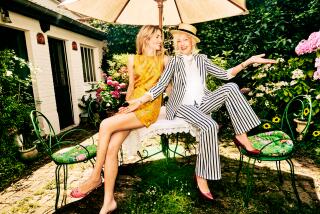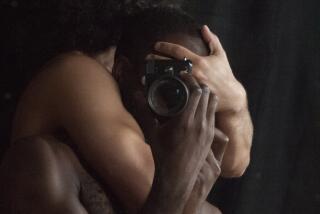Helmut Newton, 83; Provocative Master of Fashion Photography
- Share via
Helmut Newton, the renowned photographer who in his 40-year career brought sexual provocation and menace to fashion tableaux that came to be recognized as art, died Friday at Cedars-Sinai Medical Center in Los Angeles. He was 83.
Newton was in Los Angeles with his wife of 55 years, June, when he lost control of his car about noon when leaving the Chateau Marmont hotel on Sunset Boulevard and Marmont Lane.
Los Angeles Police Department spokesman Don Cox said that the car went out of control and careened across Marmont, crashing into a retaining wall across the street. Newton died shortly after being taken to Cedars-Sinai. The cause of death had not been determined, but friends said they believed he had a heart attack.
The Newtons had spent winters in Los Angeles for the last quarter-century, living at the hotel. They lived the rest of the year in Monte Carlo.
Considered, along with Irving Penn and Richard Avedon, as one of the masters of 20th century fashion photography, Newton was a ringmaster of stylish fantasies, an outsized personality who was known for creating dramatic, erotic layouts.
The best-remembered Newton photographs in Vogue and other fashion magazines featured long-legged models wearing high heels and dark lipstick lounging in Riviera swimming pools, beaches or parks. The backdrops were dark streets, elegant mansions and grand hotels where women were chased by spies and attended to by gigolos.
The effect was one of decadence interrupted, as if the scenes had been snatched from a mysterious, sexy movie.
“His photographs had more of a signature than any photographer I can think of,” Vogue editor Anna Wintour said Friday by phone from New York. “They would soar off the page. The Helmut Newton woman has become part of the vocabulary of fashion photography. Like a great designer, he didn’t waver from his point of view. Fashion would change, but Helmut’s vision didn’t.”
Born into the Jewish bourgeoisie Oct. 31, 1920, in Berlin, Newton began his photographic career in Australia and later settled in Paris and Monaco.
In his 2003 book “Helmut Newton Autobiography,” he explained how images from the Berlin demimonde he knew as a child informed his later work. The towering women were reincarnations of “great big” East Prussian housemaids who worked in his wealthy household. He remembered his parents taking cures in the summer at spa hotels where “a gigolo and a gigolette sat at separate tables away from the customers.”
Newton, who bought his first camera in 1932, was forced to leave Germany in 1938 when life became increasingly dangerous for Jews. He left on a boat for China, which had no Jewish quotas, but disembarked in Singapore.
After Germany invaded France, German Jews were declared enemy aliens in Singapore. His German passport had expired, and he was sent to an internment camp near Melbourne. After he was released, he served in the Australian army and began working as a photographer, contributing to Australian Vogue. He returned to Europe in 1961 and he worked for the French, English and American editions of Vogue.
Newton met his wife, actress June Browne, in Australia in 1946 when she came to be photographed. She later became a photographer as well -- her nom de plume was Alice Springs -- and shared his professional and social life. Their friends described their marriage -- the couple had no children -- as a great love affair.
Although his photographs would hardly be considered realistic, he told Phyllis Posnick, the executive editor of Vogue, that he photographed real life.
“It was Helmut Newton’s world, as he saw it,” Posnick, who worked closely with Newton for many years, said Friday. “And in Monte Carlo, in the days of the jet set, that was a kind of real life.”
The Newton style influenced such film directors as Stanley Kubrick, Brian de Palma and Roman Polanski, as well as such photographers as David Bailey, Mario Testino and the late Herb Ritts. Newton was inspired by Erich von Stroheim and Brassai’s pictures of Paris by night.
Among the models most associated with Newton are Nadja Auerman, Cindy Crawford, Lisa Taylor and actress Charlotte Rampling.
“A fashion photograph is almost a social document. The older it gets, the more interesting it is,” Newton told Newsweek in November. “It shows you how people lived -- in my pictures, anyway.”
Newton’s photographs were often dark and sinister, but his personality was not.
“I rarely met anyone who loved life and had as much fun as Helmut and June,” Posnick said. “He was open, generous, warm and sweet. He had an enormously good time.”
Part of the fun was being a bad boy. He famously shot nudes, and some of his photos incorporated the iconography of sadomasochism -- dog collars and leather -- so his pictures were often seen as shocking.
“He loved to provoke,” Wintour said. “People in the Midwest would be horrified by some of the images we would publish. Helmut would say, ‘Send me the letters.’ If there were none, he’d be terribly disappointed.”
Joan Juliet Buck, former editor of French Vogue, said Newton and his wife “taught everyone how to live. The Newtons were gregarious and had a large group of friends. Their enthusiasm and social life didn’t diminish with age.”
Robert Sobieszek, head of the photography department at the Los Angeles County Museum of Art, noted: “His work was never dirty. It was good clean fun, but he stretched the boundaries of what a fashion magazine looked like. He bought a sense of whimsy, a sense of fun, a sense of passion that was totally his. Many artists owe a debt to Helmut.”
Newton’s photographs sold for $80,000 to more than $200,000 at auction, said G. Ray Hawkins, whose Los Angeles gallery handled Newton’s work. His photographs are in the permanent collections of museums throughout the world, and numerous gallery shows have been devoted to his work.
Last year, he donated more than 1,000 pictures to a new gallery in Berlin, saying he was proud that his work would be on display in his hometown.
Chancellor Gerhard Schroeder called his decision a sign of reconciliation.
“You can chase a man out of his home but you can’t rip his home out of his soul,” Schroeder said at the time of the donation.
Newton published seven books of standard size and, in 1999, “Sumo,” a hand-bound, signed coffee table of a book that came with its own stand and cost $3,000.
Benedikt Taschen, the German publisher of illustrated books who issued “Sumo,” said Friday by phone from Germany: “I would never say Newton was a great fashion or a great nude photographer. He was just a great photographer. He did the most amazing portrait photography I have ever seen.”
Wintour said Newton’s last portfolio for Vogue would be published in the magazine’s March issue.
She said it features a model in a gold Gucci bathing suit, lying on a bed of nails.
*
Times staff writer Suzanne Muchnic contributed to this report.
More to Read
The biggest entertainment stories
Get our big stories about Hollywood, film, television, music, arts, culture and more right in your inbox as soon as they publish.
You may occasionally receive promotional content from the Los Angeles Times.










